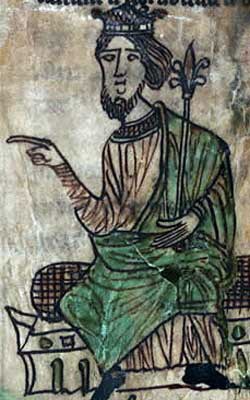Brychan Brycheiniog was born circa 419 AD and was the King of Brycheiniog. He was the son of King Anlach of Garthmadrun and Marchel. He was born in Ireland but soon after his birth moved with his parents to modern day Wales. At the age of four he was tutored by a holy man called Drichan by the River Ysgir
He was schooled for seven years and this is where a legend surrounding his future comes from. Just before the blind Drichan died he asked Brychan to bring with him his spear. With it he pointed to a nearby boar and stag that had come from the forest to stand with a fish by the river by a beech-tree dripping with honey and Drichan predicted a happy and abundant future for the young Brychan.
A few years later war broke out between Anlach and Banadl (the usurping Irish King of Powys). The fight didn’t go well for Anlach and Brychan was sent to Powys as hostage in order to protect their lands. Brychan was treated well at the Irish man’s court and fell madly in love with Banadl’s daughter Banhadlwedd. The match though was not a good one and not reciprocated. Brychan ended up taking Banhadlwedd by force. They had a son Cynog and Brychan gave the child a golden armilla as a sign of paternal recognition.
Back in Garthmadrun, Anlach had died and the Brychan was crowned the new king. His reign was a success just as Drichan had predicted and due to this success the people decided to rename the kingdom Brycheinog in Brychan’s honour. Brycahn married three times and it is said that he had 24 sons and 24 daughters. Together they are known as the ‘Holy Families of Britain. Brychan was known as a saintly king full of piety.
Despite his piety, Brychan was fierce warrior and known for defending his lands if the need arose. One of his eldest daughters Gwladys was abducted by King Gwynllyw of Gwynllwg. Brychan and his armies pursued them. A battle took place where it is said that many lives were lost. It is then said that the High-King Arthur intervened and acted as mediator between the two and they became reconciled.
On another occasion the King of Dyfed tried to raid Brycheiniog. When Brychen found out he raised his army and led them to victory expelling the raiding army from his lands. After the battle the dismembered limbs of the enemy were collected as trophies.
In old age Brychen is said to have abdicated the throne to become a hermit. He was succeeded in Brycheiniog by his eldest son Rhain Dremudd. Rhain’s line then ruled over the kingdom uninterrupted until the mid of the 7th Century.
So much of the stories of Brychen are shroud in legend and myth. It is hard to try and establish the fact from the fiction. An important note is that Brychen is important to the Arthurian story with him being mentioned as the reconciler in one of Brychen’s disputes.



